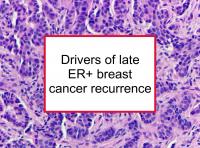Breast cancer can recur many years after initial diagnosis and treatment. This phenomenon is known as late recurrence. Early recurrence (within the first three years) is most likely for aggressive subtypes such as triple negative (ER-/PR-/HER2-) and inflammatory breast cancer (IBC) compared to hormone receptor positive (ER+/PR+/HER2-).
However, while ER+/PR+ disease tends to be more indolent, it is more likely to recur many years after diagnosis than more aggressive disease.
Now a new study has reported that late recurrence among women with hormone receptor positive breast cancer is most strongly linked to large tumor size and positive lymph nodes.
Why breast cancer can recur decades after treatment
Under one theory, when breast cancer cells leave the primary tumor through the lymph system or bloodstream, they can exist in two states initially: solitary dormant cells and active micrometastases that have not yet developed their own blood supplies. Solitary dormant breast cancer cells can exist in a quiescent state, thereby avoiding being eliminated by cytotoxic treatments that might be effective against the same cells when they are in an actively dividing state. Some researchers have suggested that such dormant cells may in fact be breast cancer stem cells, which lack the cell receptors of breast cells and, as such, are also insensitive to hormonal therapy. It is unclear what factors would promote awakening of dormant breast cancer cells.
ER+/PR+/HER2- breast cancer with low risk of late recurrence
Generally speaking, hormone receptor positive breast cancer with all of the following characteristics has a very low risk of late recurrence (i.e., relapse that takes place at least five to seven years after the initial breast cancer diagnosis):
- Tumor was found by breast cancer screening and could not be felt by hand (was not palpable)
- Tumor size ≤ 1.9 cm
- Lymph node negative (no lymph node metastases)
- Single tumor in one breast (not multicentric, multifocal or diffuse)
- Clear surgical margins when tumor was removed.
ER+/PR+/HER2- breast cancer with higher risk of late recurrence
Several studies have reported that the only factor that late recurrences tend to have in common is that the original tumor was ER+/PR+/HER2-. However, other studies have identified a few variables concerning the primary tumor or its treatment that appear to be associated with higher risk of late recurrence. We summarize these factor here:
- Tumor size ≥ 2 cm
- Lymph node positive (lymph node metastases)
- Treated with lumpectomy without any radiation treatment
- Obesity (BMI ≥ 30 kg/m2).
Implications for breast cancer survivors
While some are at higher risk than others, almost all breast cancer survivors are at risk of late recurrence. Late recurrences tend to be more treatable than early recurrences and survival can be significantly longer. However, several studies have reported that early detection of breast cancer recurrences results in significantly longer survival compared to late detected recurrences. In particular, survival is better when a recurrence is found by mammography or in patients without symptoms compared to those with symptoms. Therefore, it is important for breast cancer survivors to remain vigilant by continuing their relationships with their oncologists, undergoing regular mammograms or other diagnostic tests, and performing breast self-exams (if possible). In addition, it makes sense to maintain a chemopreventive breast cancer diet and lifestyle.
Latest research links late recurrence to tumor size and lymph nodes
The Japanese study referenced at the beginning of this news story was designed to investigate factors associated with recurrence in women with ER+/HER2- breast cancer. The study included 372 breast cancer patients with recurrences, each of whom were matched with two breast cancer patients without relapses. There were 108 premenopausal and 115 postmenopausal breast cancer patients with early distant recurrences, in addition to 62 premenopausal and 87 postmenopausal women with late distant recurrences. All of the women were ER+ and HER2- and had received their initial treatment for breast cancer during the period 2000 to 2004.
Among premenopausal women, early recurrence was associated with large tumor size, positive lymph nodes, and high tumor grade. Late recurrence was associated with large tumor size and high number of positive nodes.
Among postmenopausal women diagnosed under age 60, early recurrence was associated with bilateral breast cancer, large tumor size, positive lymph nodes, low progesterone (PR) expression and high Ki-67 (proliferation). Late recurrence was also associated with large tumor size and positive lymph nodes in this age group.
Among postmenopausal women diagnosed at age 60 or older, early recurrence was associated with bilateral breast cancer, large tumor size, positive lymph nodes, high tumor grade, low ER expression and high Ki67. Late recurrence was associated with positive lymph nodes, low ER expression and short duration of adjuvant endocrine therapy.
The authors conclude that predictors of early and late breast cancer recurrence appear to vary according to menopausal status and age.
Please see our late recurrence tag and our article on ER+/PR+ breast cancer prognosis for more information.
